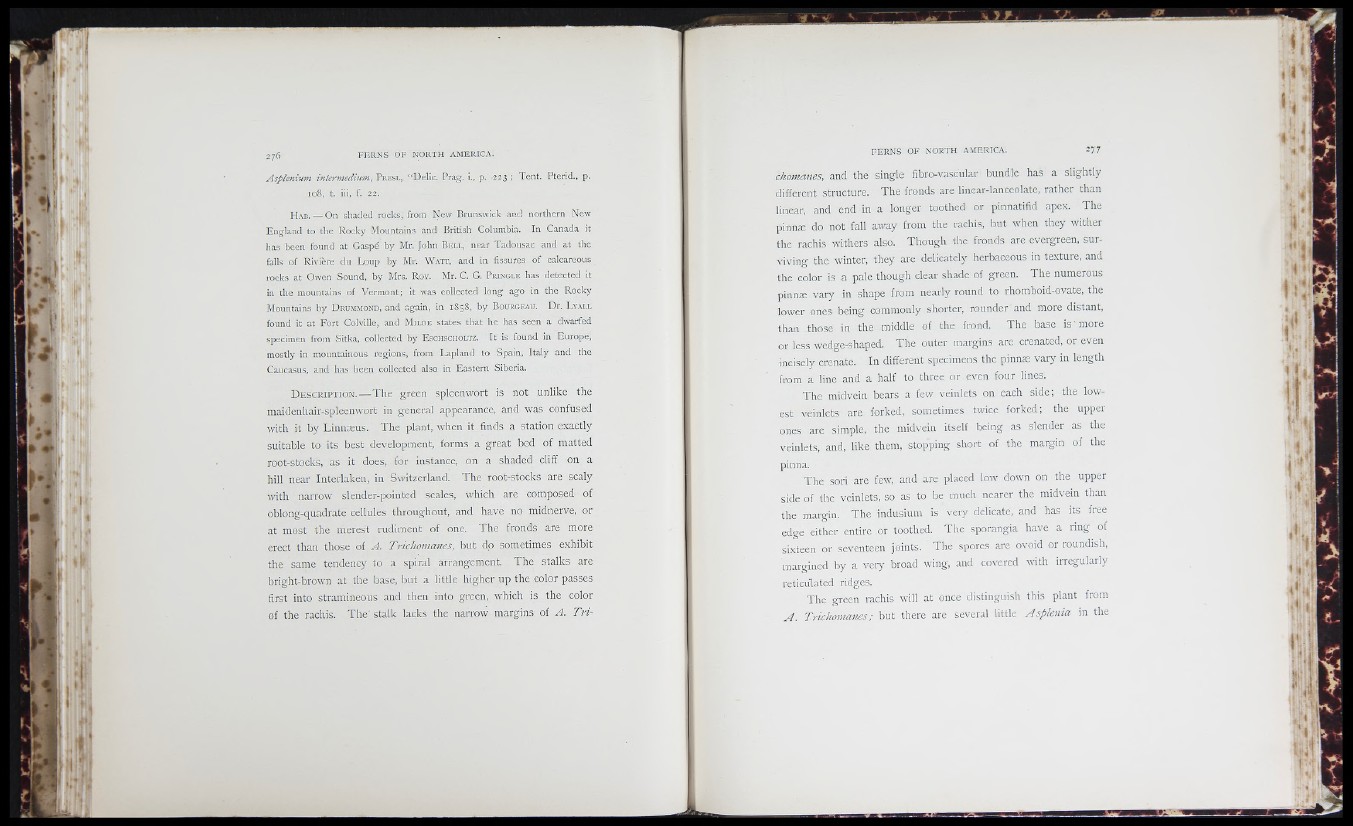
r '
w
M
I * .
T '
; ¿*1
i ®
I»
■ “ ♦ i ’
¥ ■
iJ* ' t ri
¡Di
\ >
!
1 *
' j '
276 F F .RN S O F N O R TH AM EK IC it.
Asplenium intermedium. P r e s i ., “ Delie. Prag. i., p. 223 ; Tent. Pterid., p.
108, t. iii, f. 22.
H a b . — On shaded rocks, front New Brunswick and northern New
England to the Rocky Mountains and British Columbia. In Canada it
has been found at Caspe by Mr. John B e l l , near Tadousac and at the
falls of Riviere du Loup by Mr. W a t t , and in fissures of calcareous
rocks at Owen Sound, by Mrs. R o y . Mr. C. G. P r in g l e has detected it
in the mountains of Vermont; it was collected long ago in the Rocky
Mountains by D r u m m o n d , and again, in 1858, by B o u r g e a u . Dr. L y a l l
found it at Fort Colville, and M il d e states that he has seen a dwarfed
specimen from Sitka, collected by E s c h s c h o l t z . It is found in Europe,
mostly in mountainous regions, from Lapland to Spain, Italy and the
Caucasus, and has been collected also in Eastern Siberia.
D e s c r i p t i o n . — The green spleenwort is not unlike the
maidenhair-spleenwort in general appearance, and was confused
with it by Linnæus. The plant, when it finds a station exactly
suitable to its best development, forms a great bed of matted
root-stocks, as it does, for instance, on a shaded cliff on a
hill near Interlaken, in Switzerland. The root-stocks are scaly
with narrow slender-pointed scales, which are composed of
oblong-quadrate cellules throughout, and have no midnerve, or
at most the merest rudiment of one. The fronds are more
erect than those of A. Trichomanes, but dp sometimes exhibit
the same tendency to a spiral arrangement. The stalks are
bright-brown at the base, but a little higher up the color passes
first into stramineous and then into green, which is the color
of the rachis. The' stalk lacks the narrow margins of A. Trit
i
. X
F E R N S O F N O R TH AMERICA. ~ ) 1
chomanes, and the single fibro-vascular bundle has a slightly
different structure. The fronds are linear-lanceolate, rather than
linear, and end in a longer toothed or pinnatifid apex. The
pinnæ do not fall away from the rachis, but when they wither
the rachis withers also. Though the fronds are evergreen, surviving
the winter, they are delicately herbaceous in texture, and
the color is a pale though dear shade of green. The numerous
pinnæ vary in shape from nearly round to rhomboid-ovate, the
lower ones being commonly shorter, rounder and more distant,
than those in the middle of the frond. The base is'more
or less wedge-shaped. The outer margins are crenated, or even
incisely crenate. In different specimens the pinnæ vary in length
from a line and a half to three or even four lines.
The midvein bears a few veinlets on each side; the lowest
veinlets are forked, sometimes twice forked; the upper
ones are simple, the midvein itself being as slender as the
veinlets, and, like them, stopping short of the margin of the
pinna.
The sori are few, and arc placed low down on the upper
side of the veinlets, so as to be much nearer the midvein than
the margin. The indusium is very delicate, and has its free
edge either entire or toothed. The sporangia have a ring of
sixteen or seventeen joints. The spores are ovoid or roundish,
margined by a very broad wing, and covered with irregularly
reticulated ridges.
The green rachis will at once distinguish this plant from
A . Trichomanes : but there are several little Asplenia in the
E ■
\
»
f
« t ■
A I